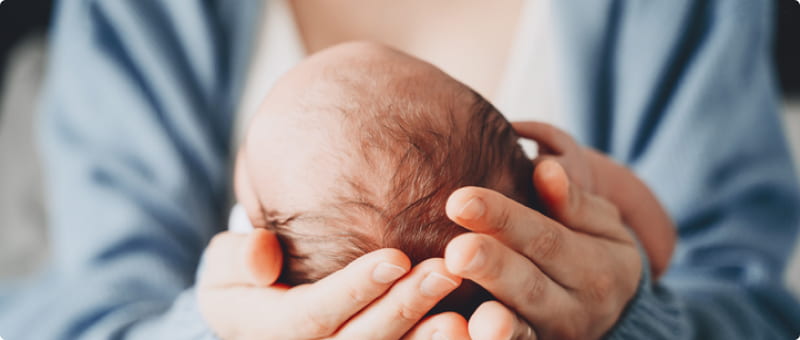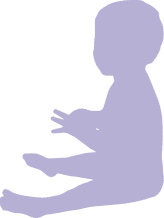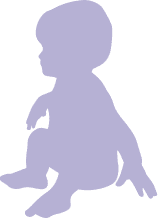What Is Infant Brain Damage?

Newborn brain damage refers to injuries or harm to an infant’s brain during pregnancy, childbirth, or shortly after birth. The causes of brain damage in infants include not getting enough oxygen, physical trauma, and infections.
Brain damage in infants can lead to a range of complications, such as developmental delays, physical disabilities, cognitive impairments, and neurological disorders. Early detection of infant brain damage symptoms is vital to get the best treatment and care for your baby.
Connect with one of our labor and delivery nurses in confidence if you have questions. There is no cost or obligation.
What Are Common Infant Brain Damage Symptoms?
There are several physical infant brain damage symptoms, including abnormal head or spine shape, seizures and tremors, limp or stiff muscles, and stiffness of the neck.
Here is more information on common infant brain damage symptoms.
1. Head Shape
One of the most common symptoms of newborn brain damage is an abnormally shaped head, such as a large forehead or a smaller-than-average head.
2. Spine Shape
Babies with abnormal spine shapes, such as curved spines, are more likely to have suffered brain damage.
Spine shape abnormalities can happen when doctors strain a baby’s neck by twisting, pulling, or using assistive delivery tools to help guide a baby from the birth canal causing issues like forceps delivery complications.
3. Seizures or Tremors
Brain damage can cause seizures and tremors in newborns as well.
Seizures are abnormal, sudden electrical activity in the brain.
- Changes in vision and eye movement
- Extreme tiredness post-seizure
- Lip smacking or chewing
- New outbursts of tearfulness
- Unusual movement of the arms, legs, head, or eyes
Tremors are shaking movements in one or more body parts, such as the hands, head, vocal cords, or torso. The rhythmic patterns are caused by unintentional muscle contractions.
4. Limp or Stiff Muscles
Limp or stiff muscles may indicate conditions like cerebral palsy or Erb’s palsy, which are caused by brain and nerve damage.
Cerebral palsy is a group of disorders affecting muscle tone or posture. It can cause impaired movement characterized by floppiness, exaggerated reflexes, unusual posture, unsteady walking, or involuntary movements.
Erb’s palsy or Erb-Duchenne paralysis affects the arms and is caused by injury to the upper group of the main nerves supplying the arm (brachial plexus).
5. Stiffness of the Neck or Inability to Lift the Head
Stiffness of the neck is another one of the common infant brain damage symptoms.
Additionally, if your child cannot lift their head independently by the age of six months, you should alert a medical professional.
6. High-Pitched Crying
Babies with neurological impairment may have high-pitched fussy cries that sound like pain cries. Children with brain damage are more sensitive to stimuli, resulting in increased fussiness.
7. Trouble Eating and Swallowing
Babies with infant brain injuries may have difficulties eating and swallowing.
If your child has trouble eating and swallowing, they can be fed through a nasogastric tube that goes from the nose to the small intestine or stomach. More long-term feeding problems may require your child to get a gastrostomy tube, a surgically placed tube that gives direct access to the stomach.
8. Excessive Drooling
Children with brain injuries may experience excessive drooling due to problems with swallowing.
9. Back Arching
Arching of the back (opisthotonus) is an abnormal posture where the back becomes arched due to muscle spasms. It is usually a sign of serious brain injuries caused by trauma, tetanus, or meningitis.
10. Sensitivity to Light
Brain damage can cause light sensitivity (discomfort around bright lights). If you notice your child crying when exposed to bright lights and the sun, consider taking them to the doctor to see whether it could be one of the infant brain damage symptoms.
11. Eye Movement Disorders
Problems with eye movement are common after a brain injury. Examples of these eye movement issues include jerky eyes, poor eye tracking, and nystagmus (a condition where the eyes make uncontrolled, repetitive movements).
12. Injury to the Scalp or Head
Brain damage may result from physical trauma inflicted on the baby’s head. For example, the mother’s birth canal or pelvis may place pressure on the baby’s skull for a long period of time, causing brain and head injury, such as a skull fracture.
Remember: Infant brain damage symptoms may not appear for months or even years after childbirth. So it is important to monitor your baby’s developmental milestones, especially if you suspect newborn brain damage.
Take our free milestone quiz now to see if your baby is on track.
IS YOUR CHILD MISSING DEVELOPMENTAL MILESTONES?
Take Our Milestones Quiz
Taking note of your child’s physical, social, and emotional skills can help you determine if they potentially suffered from an injury at birth. An early diagnosis can help your child get the treatment they need as soon as possible.
Q1: How old is your child?
0-2 MONTHS DEVELOPMENTAL MILESTONES QUIZ
- Q2: Can your child hold their head steadily on their own?
- Q3: Can your child push themselves up when they are lying on their stomach?
- Q4: Has your child started to make smoother movements with their arms and legs?
- Q5: Does your child smile at other people?
- Q6: Can your child bring their hands to their mouth?
- Q7: Does your child turn their head when they hear a noise?
- Q8: Does your child coo or make gurgling noises?
- Q9: Does your child follow things with their eyes?
- Q10: Does your child try to look at their parents or caregivers?
- Q11: Does your child show boredom, cry, or fuss when engaged in an activity that hasn’t changed in a while?


3-4 MONTHS DEVELOPMENTAL MILESTONES QUIZ
- Q2: Can your child hold their head steadily on their own?
- Q3: Does your child push down on their legs when their feet are on a flat surface?
- Q4: Has your child started to roll over from their stomach to their back?
- Q5: Can your child hold and shake a toy such as a rattle?
- Q6: Does your child bring their hands to their mouth?
- Q7: Does your child play with people and start to cry when the playing stops?
- Q8: Does your child smile spontaneously, especially at people?
- Q9: Does your child copy some movements and facial expressions of other people?
- Q10: Does your child babble with expressions and copy sounds they hear?
- Q11: Does your child cry in different ways to show hunger, pain, or tiredness?
- Q12: Does your child respond to affection like hugging or kissing?
- Q13: Does your child follow moving things with their eyes from side to side?
- Q14: Does your child recognize familiar people at a distance?


5-6 MONTHS DEVELOPMENTAL MILESTONES QUIZ
- Q2: Can your child roll over on both sides (front to back/back to front)?
- Q3: Has your child begun to sit without support?
- Q4: Does your child rock back and forth?
- Q5: Can your child support their weight on their legs (and perhaps bounce) when standing?
- Q6: Has your child begun to pass things from one hand to the other?
- Q7: Does your child bring objects such as toys to their mouth?
- Q8: Does your child know if someone is not familiar to them and is a stranger?
- Q9: Does your child respond to other people’s emotions, such as a smile or a frown?
- Q10: Does your child enjoy looking at themselves in the mirror?
- Q11: Does your child look at things around them?
- Q12: Does your child respond to sounds they hear by making sounds themselves?
- Q13: Does your child make sounds to show joy or displeasure?
- Q14: Does your child respond to their own name?
- Q15: Has your child started to string vowels together, such as "ah," "eh," or "oh," or started to say consonant sounds such as "m" or "b"?
- Q16: Has your child begun to laugh?


7-9 MONTHS DEVELOPMENTAL MILESTONES QUIZ
- Q2: Can your child crawl?
- Q3: Can your child stand while holding on to something to support them?
- Q4: Can your child sit without support?
- Q5: Can your child pull themselves up to stand?
- Q6: Does your child play peekaboo?
- Q7: Can your child move things from one hand to the other?
- Q8: Can your child pick small things up, such as a piece of cereal, with their thumb and index finger?
- Q9: Does your child look for things that they see you hide?
- Q10: Does your child watch the path of something as it falls?
- Q11: Does your child show fear when around strangers?
- Q12: Does your child become clingy with adults who are familiar to them?
- Q13: Does your child have favorite toys?
- Q14: Does your child use their fingers to point?
- Q15: Does your child understand “no”?
- Q16: Does your child make a lot of repetitive sounds, such as “mamama” or “bababa”?
- Q17: Does your child copy the sounds and gestures of other people?


10-12 MONTHS DEVELOPMENTAL MILESTONES QUIZ
- Q2: Can your child stand alone with no support?
- Q3: Does your child walk while holding on to furniture?
- Q4: Can your child take a few steps without holding on to anything?
- Q5: Can your child get into a sitting position without any help?
- Q6: Does your child bang two things together when playing?
- Q7: Does your child poke with their index finger?
- Q8: Has your child started to use things like hairbrushes or drinking cups correctly?
- Q9: Does your child find hidden objects easily?
- Q10: Does your child play peekaboo or pat-a-cake?
- Q11: Does your child become shy or nervous around strangers?
- Q12: Does your child repeat actions or sounds to get attention?
- Q13: Does your child put out an arm or leg to help when getting dressed?
- Q14: Does your child cry when a parent leaves the room?
- Q15: Does your child show that they have favorite things or people?
- Q16: Does your child show fear?
- Q17: Does your child say things such as “mama,” “dada,” or “uh-oh”?
- Q18: Does your child try to say the words you say?
- Q19: Has your child started to use gestures like waving or shaking their head “no”?


13-18 MONTHS DEVELOPMENTAL MILESTONES QUIZ
- Q2: Can your child walk by themselves?
- Q3: Does your child walk up stairs and run?
- Q4: Does your child pull toys while walking?
- Q5: Can your child drink from a cup on their own?
- Q6: Can your child eat with a spoon on their own?
- Q7: Can your child help undress themselves?
- Q8: Does your child have occasional temper tantrums?
- Q9: Does your child show affection to familiar people?
- Q10: Does your child become clingy in new situations?
- Q11: Does your child explore their environment alone with parents close by?
- Q12: Can your child say several single words?
- Q13: Can your child say and shake their head “no”?
- Q14: Does your child point to show things to other people?
- Q15: Does your child scribble?
- Q16: Does your child know what ordinary products such as phones, spoons, and brushes are used for?
- Q17: Can your child follow one-step commands such as “sit down” or “stand up”?
- Q18: Does your child play with a doll or stuffed animal by pretending to feed it?


19-23 MONTHS DEVELOPMENTAL MILESTONES QUIZ
- Q2: Has your child begun to run?
- Q3: Has your child kicked a ball?
- Q4: Can your child climb down and onto furniture on their own?
- Q5: Can your child walk up and down stairs while holding on?
- Q6: Can your child stand on their tiptoes?
- Q7: Has your child thrown a ball overhand?
- Q8: Does your child copy others, especially people older than them?
- Q9: Does your child get excited around other children?
- Q10: Has your child shown more independence as they've aged?
- Q11: Does your child do what they were told not to do and become defiant?
- Q12: Does your child point to things when they are named?
- Q13: Does your child know names of familiar people or body parts?
- Q14: Does your child say 2 to 4-word sentences?
- Q15: Does your child repeat words they hear?
- Q16: Does your child complete sentences and rhymes in familiar books?
- Q17: Does your child name items in books, such as dogs, cats, and birds?
- Q18: Does your child play simple pretend games?
- Q19: Has your child started to use one hand more than the other?
- Q20: Has your child begun to sort shapes and colors?
- Q21: Does your child follow 2-step instructions, such as “pick up your hat and put it on your head?”


24+ MONTHS DEVELOPMENTAL MILESTONES QUIZ
- Q2: Can your child run easily?
- Q3: Can your child climb?
- Q4: Can your child walk up and down stairs with one foot on each step?
- Q5: Can your child dress and undress themselves?
- Q6: Does your child show affection for friends without being told?
- Q7: Does your child take turns when playing games?
- Q8: Does your child show concern when others are crying?
- Q9: Does your child understand the idea of “mine" and "theirs"?
- Q10: Does your child show many different emotions?
- Q11: Does your child copy adults and friends?
- Q12: Does your child separate easily from their parents?
- Q13: Does your child get upset when there is a major change in their routine?
- Q14: Does your child say words such as “I,” “me,” “we,” “you,” and some plural nouns?
- Q15: Can your child say their first name, age, and gender?
- Q16: Can your child carry on a conversation with 2 to 3 sentences?
- Q17: Can your child work toys with buttons and other moving parts?
- Q18: Does your child play pretend with dolls, animals, or people?
- Q19: Can your child finish 3 or 4 piece puzzles?
- Q20: Can your child copy a circle when drawing?
- Q21: Can your child turn pages of a book one page at a time?
- Q22: Can your child turn door handles?


Infant Brain Damage Symptoms by Condition
Symptoms of infant brain damage vary depending on the type of birth injury a child experienced.
Here are some brain damage symptoms by condition.
Hypoxic-Ischemic Encephalopathy
Hypoxic-ischemic encephalopathy (HIE) is brain damage caused by a lack of oxygen to the brain before or after birth. Children with HIE may have developmental delays or neurological problems.
- Difficulty breathing
- Eating difficulties
- Muscle or reflex issues
- Organ failure
- Seizures
- Slow heart rate
- Trouble hearing
In severe brain damage cases, children with HIE may have delays in development and growth. They may also have intellectual disabilities or develop one of the types of cerebral palsy.
Hydrocephalus
Hydrocephalus is the buildup of fluid in the brain. The excess fluid increases the cavities (ventricles) of the brain and increases the pressure on other areas of the brain.
- Eyes fixed downward
- Irritability
- Larger-than-average head size
- Muscle tone and strength problems
- Rapid increase in head size
- Seizures
- Sleepiness
- Tense or bulging soft spot (fontanelle) on top of the head
- Vomiting and nausea
Newborn Cephalohematoma
A newborn cephalohematoma causes blood to pool under a newborn’s scalp, forming a soft bump on the head. This is especially common after a prolonged or difficult vaginal delivery. It is typically harmless and is usually caused by pressure during childbirth.
- Fatigue
- Head swelling
- Larger-than-average head size
- Pain in the skull area
- Seizures
- Soft spots on the head
A cephalohematoma doesn’t usually require treatment, but it may increase the risk of newborn infections, jaundice, and anemia, which can lead to infant brain damage.
Intraventricular Hemorrhage
Intraventricular hemorrhage (IVH) is bleeding into the ventricles (cavities) of the brain. IVH is most commonly seen in premature babies. This is because blood vessels in premature infants are more fragile.
- Decreased muscle tone
- Difficulty breathing
- Failure to reach developmental milestones
- Fatigue and excessive sleep
- Weak sucking reflex
Periventricular Leukomalacia
Periventricular leukomalacia (PVL) is a brain injury common in premature babies. It is caused by damage to the white matter around the brain’s ventricles.
PVL can also damage the nerve pathways that control motor movements, resulting in tight, spastic, and weak muscles. Babies with PVL are more likely to develop cerebral palsy and learning difficulties.
- Developmental delay
- Difficulty moving the body
- Eye movement disorders
What to Do If You Suspect Brain Damage in Your Baby
Brain damage can change your child’s life forever, especially if it’s not diagnosed or treated in time. Here’s what you should consider doing if you notice or suspect your child has infant brain damage symptoms.
Alert Your Child’s Pediatrician
Before you do anything else, tell your pediatrician about your suspicions. Your pediatrician will examine your baby and order tests to determine what is causing the symptoms.
Get Your Child Evaluated for Asphyxia and Other Damage
Your pediatrician will evaluate whether your child has suffered birth asphyxia (lack of oxygen) or other types of brain damage.
- Computed tomography (CT) for imaging
- Electroencephalogram (EEG) to examine the brain’s electrical activity
- Head ultrasound (HUS) for imaging
- Magnetic resonance imaging (MRI) for imaging
Seek Treatment for Brain Damage
After diagnosing the type and severity of your child’s brain damage, a pediatric medical team will prepare a customized treatment plan.
The treatment plan will depend on your child’s unique condition. If the brain damage is diagnosed right after birth, interventions like hypothermic treatment (which involves cooling the baby’s brain within 6 hours after delivery to reverse or prevent damage) and surgery (to treat brain damage caused by severe head trauma) may still be options.
Unfortunately, if your doctor does not diagnose brain damage until later, your child may need various interventions and therapies to treat their symptoms rather than the actual brain damage.
Find Legal Help for Newborn Brain Damage
Finding out that your baby may have brain damage can feel overwhelming. But help is available.
We partner with some of the best and most experienced birth injury law firms across the country. Together, they have recovered over $917 million for families affected by birth injuries, and they may be able to help your family too.
Our Patient Advocates are available 24/7 to listen to your story and help you determine your next steps.
Call (800) 914-1562 or connect with us through our free case review form.
Infant Brain Damage Symptoms FAQs
What are early signs of brain damage in newborns?
Early infant brain damage symptoms and signs include:
- Abnormal body postures or movements
- Delayed milestones
- Difficulty feeding
- Lack of responsiveness
- Poor muscle tone
- Seizures
- Unusual crying
If you notice any of these infant brain damage symptoms, contact your child’s doctor right away.
What causes brain damage during birth?
Many factors can cause brain damage during birth, including:
- Asphyxiation during birth: This is when the body is deprived of oxygen. It is one of the most common causes and can happen due to maternal anemia, placental abruption (detachment), infections, or airway issues. The two types of asphyxiation are hypoxia (insufficient oxygen) and anoxia (no oxygen).
- Kernicterus: Untreated severe newborn jaundice can cause a type of brain damage called kernicterus. Kernicterus can result in hearing loss and athetoid cerebral palsy.
- Preeclampsia: Preeclampsia is when a pregnant mother has high blood pressure and high protein levels in her urine. If preeclampsia develops into eclampsia (maternal seizures), the newborn may develop brain damage or even die.
- Physical injury: Physical harm during delivery, such as prolonged pressure on the skull from medical instruments or assistive delivery tools, may cause brain damage. These situations are often considered medical negligence.
Can a baby have brain damage with no symptoms?
Yes, a baby can have brain damage without exhibiting immediate symptoms. Some infant brain damage symptoms may only become apparent as the child develops and misses key milestones in cognitive, social, or physical development.
Talk with your child’s pediatrician if you suspect there is a problem, even if you haven’t noticed any symptoms of infant brain damage.
How do they test a newborn for brain damage?
Testing for brain damage in newborns typically involves a variety of methods. These include physical examination, neuroimaging techniques like MRI or CT scans, and electroencephalograms (EEG) to monitor brain activity.
In some cases, genetic tests or metabolic screening may also be conducted, especially if there are concerns but no infant brain damage symptoms are present.






